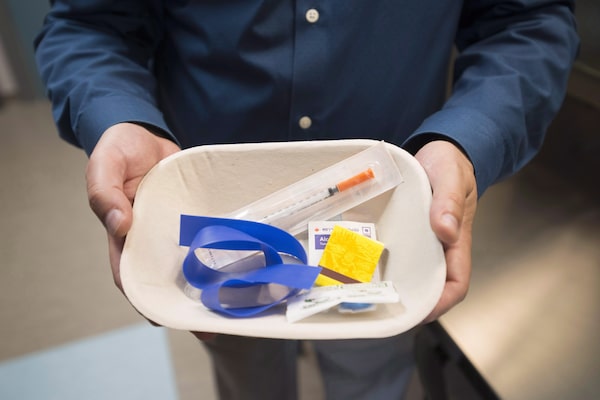
An injection kit inside the Fraser Health supervised consumption site is pictured in Surrey, B.C. on June 6, 2017.JONATHAN HAYWARD/The Canadian Press
In late March, Ontario’s Chief Medical Officer published his annual report to the province’s legislature. Its focus was drugs, from tobacco to opioids.
One line in the report stood out: “When thousands of people are dying from preventable opioid overdoses each year, the system must first take urgent steps to keep people alive,” Dr. Kieran Moore wrote.
That stark sentence lays out what no one should forget in the debate over policies to reduce drug overdose deaths, from supervised drug consumption sites and prescribed opioids to the need to rapidly expand treatment services.
British Columbia last year was the first province to experiment with decriminalization of small amount of drugs such as opioids, a policy widely backed by experts for years. B.C. is also leading on prescribed opioids, another policy supported by a range of experts that aims to provide people with drug addictions access to pharmaceuticals as an alternative to toxic unregulated street drugs.
Dr. Moore is among those who back such policies. The Canadian Association of Chiefs of Police did so in 2020. But some policies in their early days have been challenging in reality. Prescribing opioids has led to concerns about diversion and decriminalization has sparked questions of public disorder.
Amid the intensifying debate of these policies – the federal Conservatives would scrap both, after the Liberals cleared the way for provinces to experiment – some of the basic principles of harm reduction are being forgotten.
Consider supervised consumption. After a 2011 Supreme Court ruling, supervised consumption sites have become a small but established part of health care, yet availability varies. In Ontario, a site in Sudbury closed its doors this spring because of lack of funding. In Saskatchewan, the province has refused to fund the service at Saskatoon’s Prairie Harm Reduction, which recently cut its hours. Manitoba still hasn’t opened its first site in Winnipeg.
Such services must be a priority. According to federal data, from early 2017 through late 2023, these sites received 4.5 million visits, from almost 400,000 people. There were about 53,000 overdoses – but no one died, because medical care was at hand. There were also more than 400,000 referrals to other health services.
Conservatives, federally and provincially, have emphasized the importance of treatment. Treatment is everyone’s ultimate goal. But building treatment takes time and it should not come at the expense of other services. Don’t ignore Dr. Moore’s call on the urgent steps to keep people alive.
In 2021, Alberta aimed to have about 1,900 residential treatment beds by 2022, up from about 1,000 in the late 2010s. The latest number in 2023 was about 1,700. B.C. reports it has 3,601 treatment beds, up from 3,272 in mid-2022.
What’s not helpful are Alberta’s political attacks on B.C., for policies the United Conservative Party perceives as the “most radical in the world” and previous claims that B.C. invested in treatment on only a “very small scale.”
The fact is no single province has the right answers. And there is no singular right answer. In B.C., which has led on harm reduction, deaths in 2023 hit another record, 2,539 people, up 6 per cent from 2022. In Alberta, where the UCP focus on the “Alberta recovery model,” drug deaths rose 17 per cent to 1,841 in 2023 (January to November). B.C.’s rate of death was 46 per 100,000; Alberta’s was 44.
There are, however, important questions on policies such as decriminalization and prescribed opioids. This space supports both, but with prescribed opioids, minimizing diversion through measures such as supervised dosing is a valuable precautionary step. And B.C. needs to heed the lessons of Oregon, which this month scrapped a three-year experiment in decriminalization, after it launched the change without other supports such as adequate treatment in place.
Early evidence is emerging on prescribed opioids, where in B.C. less than 5 per cent of people with an opioid addiction are on the program, but data are still inconclusive. In January, a British Medical Journal study showed people in the program saw their risk of death slashed by more than half. A study in the Journal of the American Medical Association in January found that the rate of death in B.C. had not changed.
The challenge of overdose deaths requires an all-of-the-above policy approach.
Invest in treatment – and remember the most important goal: keeping people alive.